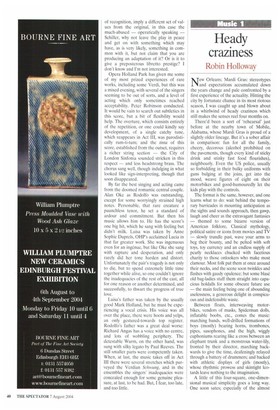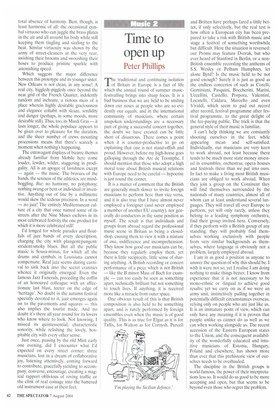Heady craziness
Robin Holloway
NewOrleans; Mardi Gras: stereotypes and expectations accumulated down the years change and pale confronted by a first experience of the actuality. Hitting the
city by fortunate chance in its most riotous season, I was caught up and blown about in a whirlwind of heady craziness which still makes the senses reel four months on.
There'd been a sort of 'rehearsal' just before at the nearby town of Mobile, Alabama, whose Mardi Gras is proud of a slightly older lineage. But it's a sober affair in comparison: fun for all the family, cheery, decorous (alcohol prohibited on the pavements, though every kind of sticky drink and stinky fast food flourishes), neighbourly. Even the US police, usually so forbidding in their bulky uniforms with guns bulging at the joins, get into the mood, weave figures of eight on their motorbikes and good-humouredly let the kids play with the controls.
The format is the same, however, and one learns what to do: wait behind the tempo rary barricades in mounting anticipation as the sights and sounds approach, then gawp, laugh and cheer as the extravagant fantasies — themed to some bizarre version of American folklore, Classical mythology, political satire or icons from movies and TV — slowly trundle past, wave your arms to beg their bounty, and be pelted with soft toys, toy currency and an endless supply of pearly necklaces chucked with facetious charity to those onlookers who make most clamour. Most folk put them at once around their necks, and the scene soon twinkles and flashes with gaudy opulence: but some blasé old bag-ladies stuff them straight into capa cious holdalls for some obscure future use — the main feeling being one of abounding uselessness, a generous delight in conspicuous and indefensible waste.
Between floats, interweaving motorbikes, vendors of masks, Spiderman dolls, inflatable boobs, etc., comes the music: marching bands, well-drilled formations of boys (mostly) bearing horns, trombones, pipes, saxophones, and the high, wiggly euphoniums rearing like a cross between an elephant trunk and a monstrous water-lily, fronted by their director, marching back wards to give the time, deafeningly relayed through a battery of drummers; and backed with athletic displays of girls (mostly), whose rhythmic prowess and skintight leotards leave nothing to the imagination.
A little of this four-square, one-dimensional musical simplicity goes a long way. One soon sates; especially of the almost total absence of harmony. Best, though, is least harmonic of all: the occasional cymbal virtuoso who can juggle the brass plates in the air and all around his body while still keeping them tingling and sizzling to the beat. Similar virtuosity was shown by the army of street-cleaners at the very rear, swishing their brooms and swooshing their hoses to produce pristine sparkle with astonishing speed.
Which suggests the major difference between this prototype and its younger sister. New Orleans is not clean, in any sense! A real city, higgledy-piggledy once beyond the neat grid of the French Quarter, indolently random and inchoate, a riotous mess of a place wherein highly desirable graciousness and elegance cohabit with sleaze, sordidity and danger (perhaps, in some moods, more desirable still). Thus, too, its Mardi Gras — it lasts longer, the whole populace appears to be given over to pleasure for the duration, and the sheer number of crews mounting processions means that there's scarcely a moment when nothing's happening.
The extravagant displays of bizarre themes already familiar from Mobile here come louder, lewder, wilder, staggering in prodigality. All is an apogee of lavishness except — again — the music. The bravura of the bands, the sexiness of the athletics, are mindboggling. But: no harmony, no polyphony; nothing swung or bent or individual or inventive. Anything out of line by a millimetre would skew the tedious precision. In a word — no jazz! The entirely Mediterranean culture of a city that once named some of its streets after the Nine Muses eschews in its most celebrated festivity the one product for which it is more celebrated still!
I'd longed for whole parades and floatfuls of jazz bands of every description, charging the city with plangent/pungent/ strident/smoky blues. But all the public music is Sousa-minus, for which all the drums and cymbals in Louisiana cannot compensate. Real jazz seems during carnival to sink back into the secret crannies whence it originally emerged. Even the famous Jazz Funerals, preceding the coffin of an honoured colleague with an affectionate last blast, teeter on the edge of 'heritage'. No doubt in the autumn festival specially devoted to it, jazz emerges again on to the pavements and squares — this also implies the tourist trade. And no doubt it's there all year round for its lovers who know where to look. Not knowing, I missed its quintessential, characteristic sonority, while relishing the lovely, hospitable city with every other sense.
Just once, passing by the old Mint early one evening, did I encounter what I'd expected on every street corner: three musicians, lost in a dream of collaborative joy, listening attentively, coming forward to contribute, gracefully yielding to accompany, converse, encourage, creating a magical rapport oblivious of roving traffic or the clink of real coinage into the battered old instrument case at their feet.



























































 Previous page
Previous page